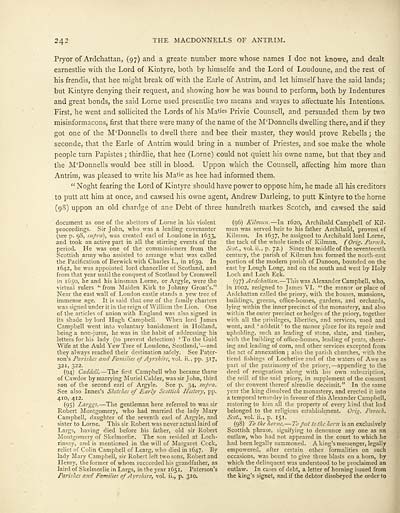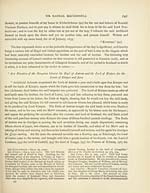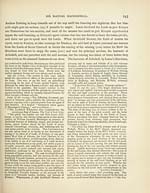Historical account of the Macdonnells of Antrim
(256) Page 242
Download files
Complete book:
Individual page:
Thumbnail gallery: Grid view | List view

242
THE MACDONNELLS OF ANTRIM.
Pryor of Ardchattan, (97) and a greate number more whose names I doe not knowe, and dealt
earnestlie with the Lord of Kintyre, both by himselfe and the Lord of Loudoune, and the rest of
his frendis, that hee might break off with the Earle of Antrim, and let himself have the said lands;
but Kintyre denying their request, and showing how he was bound to perform, both by Indentures
and great bonds, the said Lome used presentlie two means and wayes to affectuate his Intentions.
First, he went and sollicited the Lords of his Ma'ies Privie Counsell, and persuaded them by two
misinformacons, first that there were many of the name of the M'Donnells dwelling there, and if they
got one of the M'Donnells to dwell there and bee their master, they would prove Rebells ; the
seconde, that the Earle of Antrim would bring in a number of Priestes, and soe make the whole
people turn Papistes ; thirdlie, that hee (Lome) could not quiett his owne name, but that they and
the M'Donnells would bee still in blood. Uppon which the Counsell, affecting him more than
Antrim, was pleased to write his Matie as hee had informed them.
" Noght fearing the Lord of Kintyre should have power to oppose him, he made all his creditors
to putt att him at once, and cawsed his owne agent, Andrew Darleing, to putt Kintyre to the home
(98) uppon an old chardge of ane Debt of three hundreth markes Scotch, and cawsed the said
document as one of the abettors of Lome in his violent
proceedings. Sir John, who was a leading covenanter
(see p. 9S, supra), was created earl of Loudone in 1633,
and took an active part in all the stirring events of the
period. He was one of the commissioners from the
Scottish army who assisted to arrange what was called
the Pacification of Berwick with Charles I., in 1639. In
1642, he was appointed lord chancellor of Scotland, and
from that year until the conquest of Scotland by Cromwell
in 1650, he and his kinsman Lorne, or Argyle, were the
virtual rulers " from Maiden Kirk to Johnny Groat's."
Near the east wall of Loudon castle stands a yew tree of
immense age. It is said that one of the family charters
was signed under it in the reign of William the Lion. One
of the articles of union with England was also signed in
its shade by lord Hugh Campbell- When lord James
Campbell went into voluntary banishment in Holland,
being a non-juror, he was in the habit of addressing his
letters for his lady (to prevent detection) ' To the Guid
Wife at the Auld Yew Tree of Loudone, Scotland,' — and
they always reached their destination safely. See Pater-
son's Parishes and Families op Ayrshire, vol. ii., pp. 317,
321, 322.
(94) Cadddl. — The first Campbell who became thane
of Cawdor by marrying Muriel Calder, was sir John, third
son of the second earl of Argyle. See p. 34, supra.
See also Innes's Sketches of Early Scottish History, pp.
410, 412.
(95) Larggs. — The gentleman here referred to was sir
Robert Montgomery, who had married the lady Mary
Campbell, daughter of the seventh earl of Argyle, and
sister to Lorne. This sir Robert was never actual laird of
Largs, having died before his father, old sir Robert
Montgomery of Skelmorlie. The son resided at Loch-
rinsay, and is mentioned in the will of Margaret Ccck,
relict of Colin Campbell of Learg, who died in 1647. By
lady Mary Campbell, sir Robert left two sons, Robert and
Henry, the former of whom succeeded his grandfather, as
laird of Skelmorlie in Largs, in the year 165 1. Palerson's
Parishes and Families of Ayrshire, vol. ii., p. 310.
(96) Kilmun. — In 1620, Archibald Campbell of Kil-
mun was served heir to his father Archibald, provost of
Kilmun. In 1637, he assigned to Archibald lord Lome,
the tack of the whole tiends of Kilmun. ( Orig. Paroch.
Scot., vol. ii., p. 72.) Since the middle of the seventeenth
century, the parish of Kilmun has formed the north-east
portion of the modern parish of Dunoon, bounded on the
east by Lough Long, and on the south and west by Holy
Loch and Loch Eck.
(97) Ardchattan. — This was Alexander Campbell, who,
in 1602, resigned to James VI. " the manor or place of
Ardchattan called the priory, with the houses, mansions,
buildings, greens, office-houses, gardens, and orchards,
lying within the inner precinct of the monastery, and also
within the outer precinct or hedges of the priory, together
with all the privileges, liberties, and services, used and
wont, and ' acldetit ' to the manor place for its repair and
upholding, such as leading of stone, slate, and timber,
with the building of office-houses, leading of peats, shear-
ing and leading of corn, and other services excepted from
the act of annexation ; also the parish churches, with the
tiend fishings of Lochetive and of the waters of Awe as
part of the patrimony of the priory, — appending to the
deed of resignation along with his own subscription,
the seill of the said priory, in supplement of the consent
of the convent thereof alreadie deceissit." In the same
year the king dissolved the monastery, and erected it into
a temporal tenandry in favour of this Alexander Campbell,
restoring to him all the property of every kind that had
belonged to the religious establishment. Orig. Paroch.
Scot., vol. ii., p. 151.
(9S) To the home. — To put to the horn is an exclusively
Scottish phrase, signifying to denounce any one as an
outlaw, who had not appeared in the court to which he
had been legally summoned. A king's messenger, legally
empowered, after certain other formalities on such
occasions, was bound to give three blasts on a horn, by
which the delinquent was understood to be proclaimed an
outlaw. In cases of debt, a letter of horning issued from
the king's signet, and if the debtor disobeyed the order to
THE MACDONNELLS OF ANTRIM.
Pryor of Ardchattan, (97) and a greate number more whose names I doe not knowe, and dealt
earnestlie with the Lord of Kintyre, both by himselfe and the Lord of Loudoune, and the rest of
his frendis, that hee might break off with the Earle of Antrim, and let himself have the said lands;
but Kintyre denying their request, and showing how he was bound to perform, both by Indentures
and great bonds, the said Lome used presentlie two means and wayes to affectuate his Intentions.
First, he went and sollicited the Lords of his Ma'ies Privie Counsell, and persuaded them by two
misinformacons, first that there were many of the name of the M'Donnells dwelling there, and if they
got one of the M'Donnells to dwell there and bee their master, they would prove Rebells ; the
seconde, that the Earle of Antrim would bring in a number of Priestes, and soe make the whole
people turn Papistes ; thirdlie, that hee (Lome) could not quiett his owne name, but that they and
the M'Donnells would bee still in blood. Uppon which the Counsell, affecting him more than
Antrim, was pleased to write his Matie as hee had informed them.
" Noght fearing the Lord of Kintyre should have power to oppose him, he made all his creditors
to putt att him at once, and cawsed his owne agent, Andrew Darleing, to putt Kintyre to the home
(98) uppon an old chardge of ane Debt of three hundreth markes Scotch, and cawsed the said
document as one of the abettors of Lome in his violent
proceedings. Sir John, who was a leading covenanter
(see p. 9S, supra), was created earl of Loudone in 1633,
and took an active part in all the stirring events of the
period. He was one of the commissioners from the
Scottish army who assisted to arrange what was called
the Pacification of Berwick with Charles I., in 1639. In
1642, he was appointed lord chancellor of Scotland, and
from that year until the conquest of Scotland by Cromwell
in 1650, he and his kinsman Lorne, or Argyle, were the
virtual rulers " from Maiden Kirk to Johnny Groat's."
Near the east wall of Loudon castle stands a yew tree of
immense age. It is said that one of the family charters
was signed under it in the reign of William the Lion. One
of the articles of union with England was also signed in
its shade by lord Hugh Campbell- When lord James
Campbell went into voluntary banishment in Holland,
being a non-juror, he was in the habit of addressing his
letters for his lady (to prevent detection) ' To the Guid
Wife at the Auld Yew Tree of Loudone, Scotland,' — and
they always reached their destination safely. See Pater-
son's Parishes and Families op Ayrshire, vol. ii., pp. 317,
321, 322.
(94) Cadddl. — The first Campbell who became thane
of Cawdor by marrying Muriel Calder, was sir John, third
son of the second earl of Argyle. See p. 34, supra.
See also Innes's Sketches of Early Scottish History, pp.
410, 412.
(95) Larggs. — The gentleman here referred to was sir
Robert Montgomery, who had married the lady Mary
Campbell, daughter of the seventh earl of Argyle, and
sister to Lorne. This sir Robert was never actual laird of
Largs, having died before his father, old sir Robert
Montgomery of Skelmorlie. The son resided at Loch-
rinsay, and is mentioned in the will of Margaret Ccck,
relict of Colin Campbell of Learg, who died in 1647. By
lady Mary Campbell, sir Robert left two sons, Robert and
Henry, the former of whom succeeded his grandfather, as
laird of Skelmorlie in Largs, in the year 165 1. Palerson's
Parishes and Families of Ayrshire, vol. ii., p. 310.
(96) Kilmun. — In 1620, Archibald Campbell of Kil-
mun was served heir to his father Archibald, provost of
Kilmun. In 1637, he assigned to Archibald lord Lome,
the tack of the whole tiends of Kilmun. ( Orig. Paroch.
Scot., vol. ii., p. 72.) Since the middle of the seventeenth
century, the parish of Kilmun has formed the north-east
portion of the modern parish of Dunoon, bounded on the
east by Lough Long, and on the south and west by Holy
Loch and Loch Eck.
(97) Ardchattan. — This was Alexander Campbell, who,
in 1602, resigned to James VI. " the manor or place of
Ardchattan called the priory, with the houses, mansions,
buildings, greens, office-houses, gardens, and orchards,
lying within the inner precinct of the monastery, and also
within the outer precinct or hedges of the priory, together
with all the privileges, liberties, and services, used and
wont, and ' acldetit ' to the manor place for its repair and
upholding, such as leading of stone, slate, and timber,
with the building of office-houses, leading of peats, shear-
ing and leading of corn, and other services excepted from
the act of annexation ; also the parish churches, with the
tiend fishings of Lochetive and of the waters of Awe as
part of the patrimony of the priory, — appending to the
deed of resignation along with his own subscription,
the seill of the said priory, in supplement of the consent
of the convent thereof alreadie deceissit." In the same
year the king dissolved the monastery, and erected it into
a temporal tenandry in favour of this Alexander Campbell,
restoring to him all the property of every kind that had
belonged to the religious establishment. Orig. Paroch.
Scot., vol. ii., p. 151.
(9S) To the home. — To put to the horn is an exclusively
Scottish phrase, signifying to denounce any one as an
outlaw, who had not appeared in the court to which he
had been legally summoned. A king's messenger, legally
empowered, after certain other formalities on such
occasions, was bound to give three blasts on a horn, by
which the delinquent was understood to be proclaimed an
outlaw. In cases of debt, a letter of horning issued from
the king's signet, and if the debtor disobeyed the order to
Set display mode to:
![]() Universal Viewer |
Universal Viewer | ![]() Mirador |
Large image | Transcription
Mirador |
Large image | Transcription
Images and transcriptions on this page, including medium image downloads, may be used under the Creative Commons Attribution 4.0 International Licence unless otherwise stated. ![]()
| Histories of Scottish families > Historical account of the Macdonnells of Antrim > (256) Page 242 |
|---|
| Permanent URL | https://digital.nls.uk/95344319 |
|---|
| Description | A selection of almost 400 printed items relating to the history of Scottish families, mostly dating from the 19th and early 20th centuries. Includes memoirs, genealogies and clan histories, with a few produced by emigrant families. The earliest family history goes back to AD 916. |
|---|

